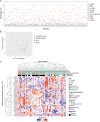MicroRNAs as Bile-based biomarkers in pancreaticobiliary cancers (MIRABILE): a cohort study
- PMID: 39041944
- PMCID: PMC11486953
- DOI: 10.1097/JS9.0000000000001888
MicroRNAs as Bile-based biomarkers in pancreaticobiliary cancers (MIRABILE): a cohort study
Abstract
Background: Biliary obstruction can be due to both malignant and benign pancreaticobiliary disease. Currently, there are no biomarkers that can accurately help make this distinction. MicroRNAs (miRNAs) are stable molecules in tissue and biofluids that are commonly deregulated in cancer. The MIRABILE study aimed to identify miRNAs in bile that can differentiate malignant from benign pancreaticobiliary disease.
Materials and methods: There were 111 patients recruited prospectively at endoscopic retrograde cholangiopancreatography (ERCP) or percutaneous transhepatic cholangiography (PTC) for obstructive jaundice, and bile was aspirated for cell-free RNA (cfRNA) extraction and analysis. In a discovery cohort of 78 patients (27 with pancreatic ductal adenocarcinoma (PDAC), 14 cholangiocarcinoma (CCA), 37 benign disease), cfRNA was subjected to small-RNA sequencing. LASSO regression was used to define bile miRNA signatures, and NormFinder to identify endogenous controls. In a second cohort of 87 patients (34 PDAC, 14 CCA, 39 benign disease), RT-qPCR was used for validation.
Results: LASSO regression identified 14 differentially-expressed bile miRNAs of which 6 were selected for validation. When comparing malignant and benign pancreaticobiliary disease, bile miR-340 and miR-182 were validated and significantly differentially expressed ( P <0.05 and P <0.001, respectively). This generated an AUC of 0.79 (95% CI: 0.70-0.88, sensitivity 65%; specificity 82%) in predicting malignant disease.
Conclusion: Bile collected during biliary drainage contains miRNAs able to differentiate benign from malignant pancreaticobiliary diseases in patients with obstructive jaundice. These bile miRNAs have the potential to increase diagnostic accuracy.
Copyright © 2024 The Author(s). Published by Wolters Kluwer Health, Inc.
Conflict of interest statement
The authors have no disclosures for this work.
Figures





References
-
- Burnett AS, Calvert TJ, Chokshi RJ. Sensitivity of endoscopic retrograde cholangiopancreatography standard cytology: 10-y review of the literature. J Surg Res 2013;184:304–311. - PubMed
-
- Bowlus CL, Olson KA, Gershwin ME. Evaluation of indeterminate biliary strictures. Nat Rev Gastroenterol Hepatol 2016;13:28–37. - PubMed
-
- Gerritsen A, Molenaar IQ, Bollen TL, et al. . Preoperative characteristics of patients with presumed pancreatic cancer but ultimately benign disease: a multicenter series of 344 pancreatoduodenectomies. Ann Surg Oncol 2014;21:3999–4006. - PubMed
-
- Abraham SC, Wilentz RE, Yeo CJ, et al. . Pancreaticoduodenectomy (Whipple Resections) in patients without malignancy: are they all ‘Chronic Pancreatitis’? Am J Surg Pathol 2003;27:110–120. - PubMed
MeSH terms
Substances
LinkOut - more resources
Full Text Sources
Medical

